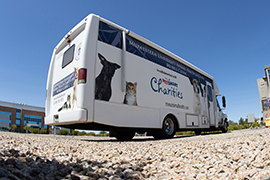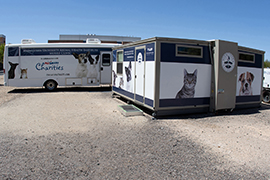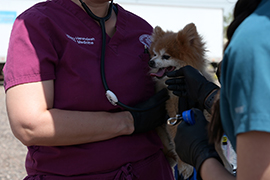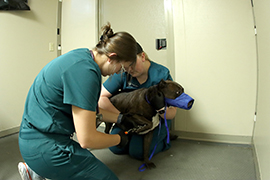- Slug: BC-CNS-Veterinarian Shortage,1700.
- 6 photos available (thumbnails, captions below).
By Sarah Min Heller
Cronkite News
GLENDALE — Veterinarians and students dashed around and huddled over exam tables, as caged dogs and cats awaited or recovered from treatment at Midwestern University’s College of Veterinary Medicine on a recent spring weekday.
“I like making an impact on animals, as well as the people who care for them,” said Jazmine Kim, who is planning to graduate from Midwestern in 2024. “The opportunities that I’ve had here are ones that I will carry with me forever.”
Kim, 32, was a vet tech before starting at Midwestern. She planned to work with wildlife, but found she enjoys dogs and cats. And because Arizona has made veterinary school extremely affordable through a new loan repayment program, this Washington state transplant is planning to practice veterinary medicine in the Grand Canyon State for at least four years.
“That was actually a big motivator for staying in the state,” Kim said. “Having a little bit of loan forgiveness and loan support was extremely tempting, incentivising, I guess, to stay in Arizona. I’ve lived in Washington for most of my life, so I think I liked the change anyway.”
Kim is helping bolster the shortfall of veterinarians in Arizona and the United States. There has been a recent decline in veterinarians and vet technicians nationally, said Stephanie Nichols-Young, president of the Animal Defense League of Arizona.
Employment of veterinarians is projected to grow 19% from 2021 to 2031, compared to 5% for all occupations, according to the U.S. Bureau of Labor Statistics. That’s in large part because new veterinarians are needed to replace ones who are retiring or leaving the occupation. The American Animal Hospital Association estimates about 2,000 veterinarians retire each year in the U.S., while others leave the often-demanding field, and only about 2,600 veterinarians graduate annually.
To help fill the gap, Arizona’s Legislature passed SB 1271 in 2022, creating the Arizona Veterinary Loan Assistance Program. It includes up to $100,000 of student loan reimbursement for veterinarians who obtain a degree after Jan. 1, 2023, and work in Arizona for at least four years. Two of those years must be at a municipal, county, or nonprofit shelter, or in an agricultural practice designated by the U.S. Department of Agriculture as having a shortage of vets.
The Arizona Humane Society, which was instrumental in pushing for the legislation, said in a statement the program was badly needed: “Animal lives have been at risk because Arizona doesn’t have enough veterinarians to provide lifesaving services at public shelters and private clinics — in both urban and rural areas. This has negatively affected pet owners, ranchers, private veterinary practices, and animal shelters and rescues across the state.”
Compounding the problem, for decades, was the fact that Arizona had no official veterinary schools. There are only about 32 accredited veterinary schools nationwide, according to the American Association of Veterinary Medical Colleges.
In 2012, Midwestern University College of Veterinary Medicine started a four-year program in Glendale, west of Deer Valley. Midwestern expects 125 vets to graduate this May. And in 2020, because the veterinarian shortage was getting more pronounced, the University of Arizona created a College of Veterinary Medicine and started a three-year program in Oro Valley, north of Tucson, enrolling 110 veterinary students out of about 518 applicants.
UArizona expects 105 vets to graduate this August. Together, the two schools will graduate about 230 veterinarians this year, and they continue to get more applications than they can accommodate. Midwestern alone said it gets more than 1,400 applicants annually for its veterinary medicine program.
At Midwestern — a private college with a main campus in Downers Grove, Illinois — students learn early on how to neuter an animal, which covers many surgery basics, according to Dr. Rachael Kreisler, associate professor of shelter medicine and epidemiology at the school.
“Our students are our primary surgeons for our cases,” said Kreisler, a veterinarian who had just finished talking to a pet owner whose cat needed its infected limb amputated. “We’re out here, trying to help the community.”
Midwestern works with nonprofits such as St. Vincent de Paul, the Humane Society and some tribal entities, including the Navajo Nation, Kreisler said. The partners schedule patients’ pets for students to learn and practice their skills in the college’s mobile surgery clinic — which was introduced in 2015 — or its pop-up clinic for non-surgery cases, introduced in 2019.
Along with the college’s mobile and pop-up clinics, it also has the Companion Animal Clinic building, which looks like a traditional vet clinic, where people can have their pets treated.
The University of Arizona has a three-year, year-round course, said Dr. Nellie Goetz, associate professor of practice at the school’s College of Veterinary Medicine. A doctor of veterinary medicine degree typically takes four years with summer breaks.
“The design of the vet school being three years was intended to address the vet shortage in that, over time, more veterinarians will be graduated due to the shorter duration of the program,” Goetz said. “They’re done a little earlier, so they’re not spending as much time in school, and also … they’re not spending as much money on school.”
UArizona’s vet program is distributive, which means there is no teaching hospital for students on campus.
“We’re sending the students out to general-practice clinics where they see things that they’re going to see every single day once they graduate from vet school,” said Goetz, adding that rather than a curriculum full of lecture classes, UArizona students engage in active learning and check their knowledge with a team of classmates.
“They stick in those teams throughout the entirety of their school education until they get to their clinical year,” Goetz said. “They sort of answer those knowledge checks together as a team, which really helps learning.”
The school also has been trying to teach students about the overall challenges of veterinary medicine and running a practice.
A 2018 study by the Centers for Disease Control and Prevention found veterinarians in the U.S. at increased risk for suicide — a trend the CDC found spanned more than three decades. Factors cited in the study included long work hours, work overload, difficult practice management responsibilities, poor work-life balance and access to euthanasia used for animals.
UArizona isn’t ignoring issues of work-life imbalance, Goetz said.
“If I’m working from 8 a.m. to 9 p.m. Monday through Friday, plus I’m not working on the weekends, but I’m called in on the weekends, or I’m answering phone calls on the weekends or texts on the weekends or things like that, I don’t have a lot of time to myself, and I’m not getting paid well. Those are really difficult things to overcome,” said Goetz.
Both Midwestern and UArizona encourage veterinary students to nurture their mental health. At UArizona, students get mental health breaks, a gym, counselors, learning specialists and mental health specialists. Midwestern has free counseling and a mental health hotline, and the school works with a chapter of Not One More Vet, a mental wellness organization for veterinarians.
“The school is very forward-thinking about those kinds of things,” said Goetz, “and really making sure they’re paying attention to what the students are feeling and thinking and what they’re going through.”
One of the side effects in Arizona of having fewer vets is an inability to offer adequate basic community services like trap-neuter-return, which is an effort to help lower the feral and stray cat population. The practice involves humanely trapping free-roaming cats, and neutering and ear-tipping them before returning them to their colony locations to stop overpopulation.
The Animal Defense League of Arizona, which specializes in TNR, says it neuters about 15,000 cats per year in Maricopa County alone. The Humane Society estimates there are 30 to 40 million outdoor, or community, cats in the United States.
When cats with microchips get trapped, their owners are contacted and asked for permission to neuter them, said Kelsey Dickerson, Arizona Humane Society media relations specialist.
“If it’s brought in by someone and they don’t know if it’s a community cat or if it’s not safe to put them back in the area that they’re from, we also have a Working Cats Program,” said Dickerson, explaining the program uses free-roaming cats that aren’t suited for inside living for adoption as pest control in warehouses, mills and barns.
With better knowledge of TNR, more cats are brought in to be neutered, which means more veterinarians will be needed. About 90% of pet owners spay or neuter their pets, Kreisler said.
Because Arizona’s loan repayment program is new, it isn’t yet clear how effective the program will be. Other states including North Dakota and Minnesota have veterinary loan repayment programs that encourage rural veterinary practice, and the U.S. Department of Agriculture offers a national Veterinary Medicine Loan Repayment Program.
Dr. Steven Hansen, president and CEO of the Arizona Humane Society, said veterinarians are able to apply for Arizona’s loan repayment program after they have graduated and received an Arizona veterinary license. Out-of-state graduates can also apply for the loan assistance if they get their veterinary license in Arizona. They must practice for four years in the state, after which they will receive the loan repayment funds, Hansen said.
Veterinary student debt averaged $157,146 in 2020, according to the American Veterinary Medical Association. Veterinarians’ median pay was $100,370 per year in 2021, according to the Bureau of Labor Statistics.
Garrett Steinbroner, 39, a UArizona student scheduled to graduate in 2024, decided not to apply for Arizona’s loan assistance program, because he’s not planning to stay in the state.
“It seems like a great option for those that want to give back to their community, are riddled with debt, and plan on living in Arizona long-term,” said Steinbroner, who said he realized he wanted to attend veterinary school after seeing several community cats being fed by security guards at a Hawaiian harbor where he was working as a first officer on a ship that was docked there. He wants to work for the Humane Society after graduating.
“You just can’t feed them. You’ve got to fix them, or there’s going to be more and more,” Steinbroner said. “The biggest possible difference you can make in the most animals’ lives — the most animals you can reach would be through TNR.”
For more stories from Cronkite News, visit cronkitenews.azpbs.org.
^__=
Midwestern University’s Animal Health Institute Mobile Clinic gives doctors and students the ability to travel around the community to help animals and pet owners. Photo taken at Midwestern University in Glendale on April 5, 2023. (Photo by Izabella Hernandez/Cronkite News)
Midwestern University took its mobile clinic to St. Vincent de Paul’s main campus in Phoenix on April 6, 2023. (Photo by Izabella Hernandez/Cronkite News)
Midwestern University takes its mobile veterinary clinic to locations where animal care is limited. The clinic is equipped for animal surgeries and general exams. Photo taken at Midwestern University in Glendale on April 5, 2023. (Photo by Izabella Hernandez/Cronkite News)
Midwestern University’s mobile veterinary clinic sits outside the university’s Animal Health Institute. The pop-up has the ability to move locations, but most of the time, it stays on campus. (Photo by Izabella Hernandez/Cronkite News)
Coco the dog gets examined by Dr. Hillary Herendeen, left, and veterinary student Emily Napoles at St. Vincent de Paul on April 6, 2023. (Photo by Izabella Hernandez/Cronkite News)
Veterinary students Michaela Brantley, left, and Mackenzie Overstreet trim the nails of a dog – coincidentally also named Coco – inside the mobile veterinary clinic at Midwestern University’s Animal Health Institute in Glendale on April 5, 2023. (Photo by Izabella Hernandez/Cronkite News)





